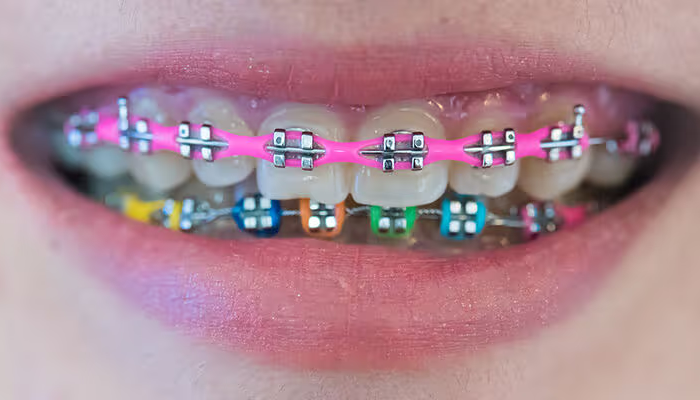
Powerchains are a crucial component in modern orthodontic treatments, often used to close spaces between teeth, correct misalignment, and expedite the movement of teeth into their desired positions. These small, elastic chains are not only functional but also significantly enhance the efficiency of braces, making them a favorite among orthodontists for targeted results.
If you’re wearing braces or considering them, understanding how powerchains work and what to expect can ease your mind and help you make informed decisions. In this article, we’ll break down the uses, benefits, and care tips for powerchains, along with answering the most frequently asked questions to ensure you’re fully informed about this powerful little tool in orthodontic care.
Understanding Powerchains: The Basics and How They Function
Powerchains are made from durable elastic materials and resemble a chain of connected O-rings. They’re attached to brackets across several teeth and exert continuous pressure to encourage tooth movement. Unlike individual ligatures, which secure wires to brackets tooth by tooth, powerchains connect multiple teeth, allowing coordinated movement and more efficient gap closure.
There are different types of powerchains—closed, short, and long spacing—each selected based on the treatment needs of the patient. Closed chains have no space between links and are often used when maximum pressure is needed, while longer-spaced chains are more flexible and apply lighter force. This customization allows orthodontists to tailor treatment plans precisely, improving outcomes for patients.
The Role of Powerchains in Orthodontic Treatment Plans
Powerchains play a pivotal role in complex orthodontic cases. They’re often employed when there’s a need to close gaps caused by tooth extraction, align rotated teeth, or reduce midline discrepancies. Because of their constant tension, powerchains can speed up treatment compared to traditional elastic ligatures alone.
Orthodontists strategically use powerchains at different stages of treatment, usually after initial alignment has occurred. Their application marks a more active phase in braces treatment, signaling accelerated progress. While the pressure may feel intense initially, it’s this force that achieves the precise movement required to shift teeth into their optimal positions.
Common Concerns and Side Effects of Powerchains
It’s natural for patients to feel some discomfort when powerchains are first installed. The pressure applied to teeth may cause soreness or tenderness for a few days, similar to the sensation felt when braces are first tightened. Over-the-counter pain relievers and soft foods can help ease this discomfort during the adjustment period.
Another concern is staining. Powerchains, especially if clear or light-colored, can discolor from foods and drinks like coffee, curry, or berries. Proper oral hygiene and avoiding staining foods can minimize this. Additionally, because powerchains are under more tension than regular ligatures, they are slightly more prone to snapping, especially if worn too long without replacement. Regular orthodontic checkups help prevent such issues and ensure consistent progress.
Caring for Your Braces When Wearing Powerchains
Maintaining excellent oral hygiene is even more critical when wearing powerchains. Food particles can get trapped more easily, and plaque buildup around the elastic material may lead to gum irritation or tooth decay if not properly managed. Brushing twice a day with a soft-bristled toothbrush, using fluoride toothpaste, and flossing with threaders or water flossers are highly recommended.
Additionally, orthodontists advise avoiding sticky, chewy, or hard foods that can dislodge the powerchains or damage brackets. Foods like caramel, popcorn, and nuts should be limited or avoided altogether. Regular orthodontic appointments are essential for monitoring progress and making timely adjustments to the powerchains for continued effectiveness.
The Aesthetic Side: Powerchain Colors and Personalization
Powerchains come in a wide variety of colors, allowing patients—especially teens and younger children—to personalize their braces experience. From bold colors like red and blue to more discreet options like clear or silver, the ability to choose colors can add a fun, expressive touch to orthodontic treatment.
Beyond aesthetics, certain colors are more practical than others. For instance, darker colors tend to resist staining better than lighter shades. Orthodontists often guide patients on the best color options based on their lifestyle and dietary habits. This blend of function and fashion makes powerchains not only effective but also customizable, turning orthodontic treatment into a more positive experience.
Conclusion: Why Powerchains Are a Game-Changer in Orthodontics
Powerchains are a small but mighty part of the orthodontic toolbox. Their ability to speed up treatment, close stubborn gaps, and enhance the alignment of teeth makes them indispensable in achieving a perfect smile. While they require a bit of extra care and can cause temporary discomfort, the long-term benefits are well worth it.
Whether you’re just beginning your braces journey or nearing the end, understanding the role and value of powerchains can help you feel more confident and proactive in your treatment. Always follow your orthodontist’s instructions, keep up with your oral hygiene, and you’ll be flashing a beautiful, healthy smile in no time.
FAQs About Powerchains
1. What is the main purpose of powerchains in braces?
Powerchains are used to close gaps, align teeth, and apply continuous pressure to accelerate tooth movement during orthodontic treatment.
2. Are powerchains painful?
They can cause mild discomfort when first applied, but this usually subsides within a few days.
3. How long do I need to wear powerchains?
The duration varies based on your treatment plan, but it typically ranges from a few weeks to several months.
4. Can I eat normally with powerchains on?
Mostly yes, but avoid hard, sticky, or chewy foods that can damage the chains or brackets.
5. Do powerchains come in different colors?
Yes! You can choose from a wide variety of colors, including clear, silver, and bold shades like red or blue.
6. Can powerchains stain?
Yes, especially lighter-colored ones. Avoid foods like coffee, curry, and berries to reduce staining.
7. Are powerchains used in Invisalign?
No, powerchains are specific to traditional braces. Invisalign uses clear aligners and other tools for movement.
8. What should I do if my powerchain breaks?
Contact your orthodontist as soon as possible for a replacement to avoid delaying your treatment.
9. How often are powerchains changed?
Usually every 4–6 weeks during regular orthodontic appointments, depending on your progress.
10. Are powerchains suitable for all orthodontic patients?
Not necessarily. They are used when specific tooth movements or gap closures are needed and are determined by the orthodontist.




